Significance and Vision of Nutrient Recovery for Sustainable City Food Systems in Germany by 2050
Abstract
:1. Introduction
2. Methodology
3. Key Elements and Enabling Technologies Based on the SUSKULT Vision of a Circular Food Supply in Urban Areas
3.1. Analysis of Urban Resource Potential
3.2. Cultivation Systems and Crop Varieties for Circular Food Supply in Urban Areas
- Use of the total biomass produced;
- Increase of valuable plants substances (primary and secondary plant constituents);
- Process engineering approaches (production system);
- A regionally differentiated or usage related species and varieties selection.
3.2.1. Tomatoes (Solanum lycopersicum)
3.2.2. Duckweed (Lemna and Wolffiella)
3.2.3. Sweet Potato (Ipomoea batatas)
3.3. Consumer Demands and Perceptions of the SUSKULT Vision
3.3.1. Consumer Awareness and Information Demands Regarding SUSKULT
- (1)
- Food security of vegetables cultivated in SUSKULT,
- (2)
- Nutritional value of vegetables cultivated in SUSKULT,
- (3)
- Sustainability of the SUSKULT approach compared to conventional agricultural cultivation systems,
- (4)
- Energy consumption and energy costs of the SUSKULT approach,
- (5)
- Consumers prices regarding final SUSKULT products,
- (6)
- Interaction of the SUSKULT approach with established agricultural production and distribution systems,
- (7)
- Impact of the SUSKULT approach on farmers near to SUSKULT cultivation systems.
3.3.2. Risk Assessment and Transparency Related to SUSKULT
4. Conclusions
Author Contributions
Funding
Institutional Review Board Statement
Informed Consent Statement
Data Availability Statement
Acknowledgments
Conflicts of Interest
References
- FAO. Cities and Local Governments at the Forefront in Building Inclusive and Resilient Food Systems. Available online: http://www.fao.org/urban-food-actions/resources/resources-detail/en/c/1305069/ (accessed on 22 March 2021).
- Van Dooren, N.; Leseman, B.; van der Meulen, S. How New Food Networks Change the Urban Environment: A Case Study in the Contribution of Sustainable, Regional Food Systems to Green and Healthy Cities. Sustainability 2021, 13, 481. [Google Scholar] [CrossRef]
- FAO. Food in an Urbanised World: The Role of City Region Food Systems in Resilience and Sustainable Development. Available online: http://www.fao.org/fileadmin/templates/agphome/documents/horticulture/crfs/foodurbanized.pdf (accessed on 22 March 2021).
- United Nations. World Urbanization Prospects: The 2018 Revision. Available online: https://population.un.org/wup/ (accessed on 15 September 2021).
- WBGU. Entwicklung und Gerechtigkeit Durch Transformation: Die vier großen I: Sondergutachten, Berlin, 2016. Available online: https://www.wbgu.de/de/publikationen/publikation/entwicklung-und-gerechtigkeit-durch-transformation-die-vier-grossen-i-innovation-investition-infrastruktur-inklusion (accessed on 7 October 2019).
- Ekins, P.; Gupta, J.; Boileau, P. Global Environment Outlook—GEO-6: Healthy Planet, Healthy People; Cambridge University Press: Cambridge, UK, 2019. [Google Scholar]
- Dubbeling, M.; Bucatariu, C.; Santini, G.; Vogt, C.; Eisenbeiß, K. City Region Food Systems and Food Waste Management: Linking Urban and Rural Areas for Sustainable and Resilient Development; Deutsche Gesellschaft für Internationale Zusammenarbeit: Eschborn, Germany, 2016; ISBN 978-92-5-109453-2. [Google Scholar]
- Eigenbrod, C.; Gruda, N. Urban vegetable for food security in cities. A review. Agron. Sustain. Dev. 2015, 35, 483–498. [Google Scholar] [CrossRef] [Green Version]
- Dubbeling, M.; Santini, G.; Renting, H.; Taguchi, M.; Lançon, L.; Zuluaga, J.; de Paoli, L.; Rodriguez, A.; Andino, V. Assessing and Planning Sustainable City Region Food Systems: Insights from Two Latin American Cities. Sustainability 2017, 9, 1455. [Google Scholar] [CrossRef] [Green Version]
- Despommier, D.D. The Vertical Farm: Feeding the World in the 21st Century, 1st ed.; Picador: New York, NY, USA, 2011; ISBN 978-0312610692. [Google Scholar]
- Aerofarms: The World’s Largest Vertical Farm. Available online: http://aerofarms.com/ (accessed on 16 February 2018).
- Ladner, P. The Urban Food Revolution: Changing the Way We Feed Cities; New Society Publishers: Gabriola Island, BC, Canada, 2011; ISBN 9780865716834. [Google Scholar]
- Kraas, F.; Leggewie, C.; Lemke, P.; Matthies, E.; Messner, D.; Nakicenovic, N.; Schellnhuber, H.J.; Schlacke, S.; Schneidewind, U. Der Umzug der Menschheit: Die Transformative Kraft der Städte; Wissenschaftlicher Beirat der Bundesregierung Globale Umweltveränderungen: Berlin, Germany, 2016; ISBN 978-3-936191-44-8. [Google Scholar]
- European Union. Farm to Fork Strategy: For a Fair, Healthy and Environmentally-Friendly Food System. Available online: https://ec.europa.eu/food/horizontal-topics/farm-fork-strategy_en (accessed on 7 January 2021).
- Schebesta, H.; Candel, J.J.L. Game-changing potential of the EU’s Farm to Fork Strategy. Nat. Food 2020, 1, 586–588. [Google Scholar] [CrossRef]
- Federal Ministry of Education and Research (BMBF); Federal Ministry of Food and Agriculture. National Bioeconomy Strategy: Summary. Available online: https://www.bmbf.de/files/2020_1501_National-Bioeconomy-Strategy_Summary_accessible.pdf (accessed on 7 January 2021).
- International Advisory Council on Global Bioeconomy. Global Bioeconomy Policy Report (IV): A Decade of Bioeconomy Policy Development around the World. Available online: https://gbs2020.net/wp-content/uploads/2020/11/GBS-2020_Global-Bioeconomy-Policy-Report_IV_web.pdf (accessed on 7 January 2021).
- Nikishanove, T.I. Plants for Space Plantations. Available online: https://strives-uploads-prod.s3.us-gov-west-1.amazonaws.com/19780019791/19780019791.pdf?AWSAccessKeyId=AKIASEVSKC45ZTTM42XZ&Expires=1602070697&Signature=ORBCOrZiW33x9HH39KslDV6%2B0G0%3D (accessed on 7 October 2020).
- Mortley, D.G.; Loretan, P.A.; Hill, W.A.; Bonsi, C.K.; Morris, C.E.; Hall, R.; Sullen, D. Biocompatibility of sweetpotato and peanut in a hydroponic system. HortScience 1998, 33, 1147–1149. [Google Scholar] [CrossRef]
- Evans, D.; Welch, D.; Swaffield, J. Constructing and mobilizing ‘the consumer’: Responsibility, consumption and the politics of sustainability. Environ. Plan. A 2017, 49, 1396–1412. [Google Scholar] [CrossRef] [Green Version]
- Koos, S. What drives political consumption in Europe? A multi-level analysis on individual characteristics, opportunity structures and globalization. Acta Sociol. 2012, 55, 37–57. [Google Scholar] [CrossRef] [Green Version]
- Forsa Politik. Ernährungsreport 2021: Ergebnisse Einer Repräsentativen Bevölkerungsbefragung; Forsa Politik: Berlin, Germany, 2021. [Google Scholar]
- Nitzko, S. Consumer requirements for food product transparency. Ernährungs Umsch. Int. 2019, 66, 198–203. [Google Scholar]
- Goess, S.; de Jong, M.; Meijers, E. City branding in polycentric urban regions: Identification, profiling and transformation in the Randstad and Rhine-Ruhr. Eur. Plan. Stud. 2016, 24, 2036–2056. [Google Scholar] [CrossRef] [Green Version]
- Bundesministerium für Ernährung und Landwirtschaft. Pro-Kopf-Verbrauch von Gemüse: Wirtschaftsjahr 2015/2016 Vorläufig. Available online: https://www.bmel-statistik.de//fileadmin/user_upload/monatsberichte/GBT-0070004-2016.pdf (accessed on 16 February 2018).
- Prieto-Sandoval, V.; Jaca, C.; Ormazabal, M. Towards a consensus on the circular economy. J. Clean. Prod. 2018, 179, 605–615. [Google Scholar] [CrossRef]
- OECD. Wastewater Treatment (% Population Connected). Available online: https://stats.oecd.org/Index.aspx?DataSetCode=WATER_TREAT (accessed on 25 August 2020).
- Statistisches Bundesamt. Statistisches Jahrbuch Deutschland 2019:—Letztmalige Ausgabe—Titel Wird Eingestellt, 1., Auflage; Statistisches Bundesamt: Wiesbaden, Germany, 2019; ISBN 978-3-8246-1086-0.
- The Council of European Communities. Council Directive of 21 May 1991 Concerning Urban Waste Water Treatment; 91/271/EEC; The Council of European Communities: Brussels, Belgium, 1991. [Google Scholar]
- Bundesamts für Justiz. Verordnung über Anforderungen an das Einleiten von Abwasser in Gewässer (Abwasserverordnung—AbwV): AbwV; Bundesamts für Justiz: Bonn, Germany, 1997.
- US EPA. National Pollutant Discharge Elimination System (NPDES) Permit Writers’ Manual; United States Environmental Protection Agency: Washington, DC, USA, 2010.
- US EPA. Status of Nutrient Requirements for NPDES-Permitted Facilities. Available online: https://www.epa.gov/npdes/status-nutrient-requirements-npdes-permitted-facilities (accessed on 25 August 2020).
- Ministry of Ecology and Environment, The People’s Republic of China. Discharge Standard of Pollutants for Municipal Wastewater Treatment Plant, Beijing: GB18918-2002; Ministry of Ecology and Environment, The People’s Republic of China: Beijing, China, 2002.
- European Commission. Communication on the List of Critical Raw Materials 2014; European Commission: Brussels, Belgium, 2014. [Google Scholar]
- European Commission. Communication on the List of Critical Raw Materials 2017; European Commission: Brussels, Belgium, 2017. [Google Scholar]
- The Swiss Federal Council. Verordnung über die Vermeidung und die Entsorgung von Abfällen (Abfallverordnung, VVEA); The Swiss Federal Council: Bern, Switzerland, 2015.
- Bundesamts für Justiz. Verordnung über die Verwertung von Klärschlamm, Klärschlammgemisch und Klärschlammkompost (Klärschlammverordnung—AbfKlärV); Bundesamts für Justiz: Bonn, Germany, 2017.
- Today DWA. Standard ATV-DVWK-A 198E—Standardisation and Derivation of Dimensioning Values of Wastewater Facilities; ATV-DVWK: Hennef, Germany, 2003. [Google Scholar]
- DWA. Merkblatt DWA-M 368 Biologische Stabilisieriung von Klärschlamm; ATV-DVWK: Hennef, Germany, 2014. [Google Scholar]
- Krebs, P. Modellierung von Abwassersystemen. Available online: https://tu-dresden.de/bu/umwelt/hydro/isi/sww/ressourcen/dateien/lehre/dateien/modabwsys_vorlesung/03modabw.pdf?lang=de (accessed on 25 September 2021).
- DWA. Arbeitsblatt DWA-A 131 Bemessung von Einstufigen Belebungsanlagen; ATV-DVWK: Hennef, Germany, 2016. [Google Scholar]
- Gujer, W. Siedlungswasserwirtschaft; Springer: Berlin/Heidelberg, Germany, 2007; ISBN 10 3-540-34329-6. [Google Scholar]
- Otterpohl, R. Design of highly efficient Source Control Sanitation and practical Experiences. In Proceedings of the EURO-Summer School DESAR, Wageningen, The Netherlands, 18–23 June 2000. [Google Scholar]
- Fassbender, H.W.; Steinert, B. Anfall und chemische Zusammensetzung der städtischen Abwässer von Wolfsburg und Braunschweig. Z. Für Pflanz. Und Bodenkd. 1979, 142, 219–231. [Google Scholar] [CrossRef]
- Imhoff, K.R.; Jardin, N. (Eds.) Taschenbuch der Stadtentwässerung; 31. verbesserte Auflage; Oldenbourg Industrieverlag: München, Germany, 2010; ISBN 978-3-8356-3291-2. [Google Scholar]
- Jardin, N. Untersuchungen zum EInfluss der Erhöhten Biologischen Phosphorelimination auf die Phosphordynamik bei der Schlammbehandlung: Schriftenreihe WAR 87; Technische Hochschule Darmstadt: Darmstadt, Germany, 1995. [Google Scholar]
- Stetzer, T. Plausibilität von Betriebsparametern; Laborgesellschaft für Umweltschutz: Kirkel-Limbach, Germany, 2007. [Google Scholar]
- DWA. Guideline DWA-M 381E—Sewage Sludge Thickening—October 2007; ATV-DVWK: Hennef, Germany, 2007. [Google Scholar]
- ATV-DVWK-Arbeitsgruppe AK-1.3. Rückbelastung aus der Schlammbehandlung-Menge und Beschaffenheit der Rückläufe. KA Wasserwirtsch. Abwasser Abfall 2000, 47, 1181–1187. [Google Scholar]
- Jardin, N. Bilanzielle Betrachtung verschiedener Verfahren zur P-Elimination. In Schriftenreihe WAR 167—Rückgewinnung von Phosphor aus Abwasser und Klärschlamm; Verein zur Förderung des Instituts WAR: Darmstadt, Germany, 2005; pp. 39–55. [Google Scholar]
- DWA. Guideline DWA-M 366E—Mechanical Dewatering of Sewage Sludge—February 2013; ATV-DVWK: Hennef, Germany, 2016. [Google Scholar]
- DWA. Merkblatt DWA-M 383 Kennwerte der Klärschlammentwässerung; ATV-DVWK: Hennef, Germany, 2019. [Google Scholar]
- DWA. Entwurf Merkblatt DWA-M 114 Abwasserwärmenutzung; ATV-DVWK: Hennef, Germany, 2019. [Google Scholar]
- US EPA. Guidelines for Water Reuse; US EPA: Washington, DC, USA, 2012.
- Eurofins Agro. Nutrient Solutions for Greenhouse Crops; Eurofins Agro: Wageningen, The Netherlands, 2016. [Google Scholar]
- Lattauschke, G. Nachtschattengewächse—Solanaceae; Ulmer: Stuttgart, Germany, 2020; ISBN 978-3-8186-0837-8. [Google Scholar]
- Pinnekamp, J.; Baumann, P.; Cornel, P.; Everding, W.; Göttlicher-Schmidle, U.; Heinzmann, B.; Jardin, N.; Longdong, J.; Meyer, C.; Mocker, M.; et al. Stand und Perspektiven der Phosphorrückgewinnung aus Abwasser und Klärschlamm—Teil 1: Zweiter Arbeitsbericht der DWA-Arbeitsgruppe KEK-1.1 ‘Wertstoffrückgewinnung aus Abwasser und Klärschlamm’. KA Korresp. Abwasser Abfall 2013, 60, 837–844. [Google Scholar]
- Egle, L.; Rechberger, H.; Krampe, J.; Zessner, M. Phosphorus recovery from municipal wastewater: An integrated comparative technological, environmental and economic assessment of P recovery technologies. Sci. Total Environ. 2016, 571, 522–542. [Google Scholar] [CrossRef] [Green Version]
- Kehrein, P.; van Loosdrecht, M.; Osseweijer, P.; Garfí, M.; Dewulf, J.; Posada, J. A critical review of resource recovery from municipal wastewater treatment plants—Market supply potentials, technologies and bottlenecks. Environ. Sci. Water Res. Technol. 2020, 6, 877–910. [Google Scholar] [CrossRef] [Green Version]
- Resh, H.M. Hydroponic Food Production: A Definitive Guidebook for the Advanced Home Gardener and the Commercial Hydroponic Grower, 7th ed.; CRC Press: Baton Rouge, LA, USA, 2016; ISBN 978-1-4398-7869-9. [Google Scholar]
- Jürgenbeck, K.; Heumann, A.; Spiller, A. Sustainability Matters: Consumer Acceptance of Different Vertical Farming Systems. Sustainability 2019, 11, 4052. [Google Scholar] [CrossRef] [Green Version]
- Sharma, N.; Acharya, S.; Kumar, K.; Singh, N.; Chaurasia, O.P. Hydroponics as an advanced technique for vegetable production: An overview. J. Soil Water Conser. 2018, 17, 364–371. [Google Scholar] [CrossRef]
- Bundesministerium für Ernährung und Landwirtschaft. Düngung. Available online: www.bmel.de/DE/themen/landwirtschaft/pflanzenbau/ackerbau/duengung.html (accessed on 31 July 2020).
- Zhou, M.; Bonenberg, W.; Wei, X.; Liu, S. How Vertical Farming Influences Urban Landscape Architecture and Sustainable Urban Developments. In Proceedings of the AHFE 2018 International Conference on Human Factors, Sustainable Urban Planning and Infrastructure, Loews Sapphire Falls Resort at Universal Studios, Orlando, FL, USA, 21–25 July 2018. [Google Scholar]
- Neuweiler, R.; Krauss, J. Düngung im Gemüsebau. Available online: www.agrarforschungschweiz.ch/wp-content/uploads/2019/12/2017_06_2303.pdf (accessed on 2 September 2020).
- Bundesanstalt für Landwirtschaft und Ernährung. Entwicklung des Selbstversorgungsgrades bei Gemüse und Obst in Deutschland. Available online: www.bmel-statistik.de/fileadmin/daten/GBT-0070010-0000.pdf (accessed on 22 July 2020).
- Collen, C. Vertical Farming Comes to Kuwait & Ever Opens the First Large-Scale Indoor Vertical Farm in the Middle East. Available online: http://www.fruitnet.com/eurofruit/article/182373/vertical-farming-comes-to-kuwait (accessed on 22 July 2020).
- Kozai, T. (Ed.) Smart Plant Factory: The Next Generation Indoor Vertical Farms; Springer: Singapore, 2018; ISBN 9811310653. [Google Scholar]
- UmweltDialog Wirtschaft.Verantwortung. Nachhaltigkeit. Klimakiller Tomaten? Lebensmittel—“Der nachhaltige Warenkorb”. Available online: www.umweltdialog.de/de/verbraucher/lebensmittel/2015/Klimakiller-Tomaten-.php (accessed on 25 July 2020).
- Majchrzak, D.; Schlinter-Maltan, C. Die Sensorische Fachsprache; Springer Fachmedien Wiesbaden: Wiesbaden, Germany, 2018; ISBN 978-3-658-22813-2. [Google Scholar]
- Petersen, F.; Demann, J.; Restemeyer, D.; Ulbrich, A.; Olfs, H.-W.; Westendarp, H.; Appenroth, K.-J. Influence of the Nitrate-N to Ammonium-N Ratio on Relative Growth Rate and Crude Protein Content in the Duckweeds Lemna minor and Wolffiella hyalina. Plants 2021, 10, 1741. [Google Scholar] [CrossRef]
- Appenroth, K.-J.; Sree, K.S.; Böhm, V.; Hammann, S.; Vetter, W.; Leiterer, M.; Jahreis, G. Nutritional value of duckweeds (Lemnaceae) as human food. Food Chem. 2017, 217, 266–273. [Google Scholar] [CrossRef] [PubMed]
- Statista Research Department. Verbraucherausgaben für Trend-Gemüse in Deutschland. 2016. Available online: https://de.statista.com/statistik/daten/studie/695778/umfrage/verbraucherausgaben-fuer-gemuese-in-deutschland/ (accessed on 25 July 2020).
- Center for Science in the Public Interest. 10 Best Foods. 1. Sweet Potatoes. Available online: https://cspinet.org/eating-healthy/what-eat/10-best-foods (accessed on 25 July 2020).
- Rajasekaran, A.; Sivagnanam, G.; Xavier, R. Nutraceuticals as therapeutic agents: A Review. Res. J. Pharm. Technol. 2008, 1, 328–340. [Google Scholar]
- Bundesanstalt für Landwirtschaft und Ernährung. Süßkartoffeln–Gemüse mit Potenzial. Available online: www.ble.de/SharedDocs/Pressemitteilungen/DE/2020/200527_Suesskartoffeln.html (accessed on 25 July 2020).
- FAO. Urban Food Systems and COVID-19: The Role of Cities and Local Governments in Responding to the Emergency; FAO: Rome, Italy, 2020. [Google Scholar]
- FAO. Sustainable Food Systems: Concept and Framework; FAO: Rome, Italy, 2018. [Google Scholar]
- Schwindenhammer, S. Authority Pooling and Regional Organic Agriculture Standard-Setting: Evidence from East Africa. J. Environ. Policy Plan. 2016, 18, 102–120. [Google Scholar] [CrossRef]
- BMEL. Gesunde Ernährung, sichere Produkte, Berlin. 2020. Available online: https://www.bmel.de/SharedDocs/Downloads/DE/Broschueren/gesunde-ernaherung-sichere-produkte-bericht.pdf?__blob=publicationFile&v=6 (accessed on 23 July 2021).
- Reisch, L.; Eberle, U.; Lorek, S. Sustainable food consumption: An overview of contemporary issues and policies. Sustain. Sci. Pract. Policy 2013, 9, 7–25. [Google Scholar] [CrossRef]
- EFSA. Regulation No. 178/2002 of the European Parliament and of the Council of 28 January 2002 Laying Down the General Principles and Requirements of Food Law, Establishing the European Food Safety Authority and Laying Down Procedures in Matters of Food Safety: No. 178/2002; EFSA: Parma, Italy, 2002.
- EFSA. Regulation (EU) 2017/625 of the European Parliament and of the Council of 15 March 2017 on Official Controls and Other Official Activities Performed to Ensure the Application of Food and Feed Law, Rules on Animal Health and Welfare, Plant Health and Plant Protection Products.: Regulation (EU) 2017/625; EFSA: Parma, Italy, 2017.
- BMEL. Understanding Food Safety: Facts and Background. Available online: https://www.bmel.de/SharedDocs/Downloads/EN/Publications/Understandingfoodsafety.pdf?__blob=publicationFile&v=4 (accessed on 15 September 2021).
- EFSA. Science Protecting Consumers: From Field to Fork. Available online: https://www.efsa.europa.eu/en/corporate/pub/corporatebrochure (accessed on 15 September 2021).
- BMEL, Deutschland, wie es isst.: Der BMEL-Ernährungsreport 2021; BMEL: Berlin, Germany, 2021; Available online: https://www.bmel.de/SharedDocs/Downloads/DE/Broschueren/ernaehrungsreport-2021.pdf;jsessionid=08074C15927266EA0BF0C4A4DFE9FD45.live922?__blob=publicationFile&v=5 (accessed on 23 July 2021).
- Vittuari, M.; Bazzocchi, G.; Blasioli, S.; Cirone, F.; Maggio, A.; Orsini, F.; Penca, J.; Petruzzelli, M.; Specht, K.; Amghar, S.; et al. Envisioning the Future of European Food Systems: Approaches and Research Priorities after COVID-19. Front. Sustain. Food Syst. 2021, 5. [Google Scholar] [CrossRef]
- Bitkom. Verbraucher Wünschen sich mehr Transparenz beim Einkauf. Available online: https://www.bitkom.org/Presse/Presseinformation/Verbraucher-wuenschen-sich-mehr-Transparenz-beim-Einkauf (accessed on 17 August 2020).
- Renn, O.; Klinke, A. A framework of adaptive risk governance for urban planning. Sustainability 2013, 5, 2036–2059. [Google Scholar] [CrossRef] [Green Version]
- Helmecke, M.; Fries, E.; Schulte, C. Regulating water reuse for agricultural irrigation: Risks related to organic micro-contaminants. Environ. Sci. Eur. 2020, 32, 4. [Google Scholar] [CrossRef] [Green Version]
- UBA. Mikroverunreinigungen in Gewässern. Available online: https://www.umweltbundesamt.de/themen/wasser/wasser-bewirtschaften/mikroverunreinigungen-in-gewaessern#undefined (accessed on 1 September 2020).
- BfR; JKI; MRI. Aufbereitete Abwässer: Bakterielle Krankheitserreger auf frischem Obst und Gemüse Vermeiden: Stellungnahme Nr. 021/2020 des BfR vom 20. April 2020, Berlin, 2020. Available online: https://bvlk.de/news/aufbereitete-abwaesser-bakterielle-krankheitserreger-auf-frischem-obst-und-gemuese-vermeiden.html (accessed on 1 September 2020).
- Havinga, T.; van Waarden, F.; Casey, D. (Eds.) The Changing Landscape of Food Governance: Public and Private Encounters; Edward Elgar: Cheltenham, UK, 2015; ISBN 9781784715410. [Google Scholar]
- UBA. Empfehlungen zur Reduzierung von Mikroverunreinigungen in den Gewässern; UBA: Dessau-Roßlau, Germany, 2018. [Google Scholar]
- Schwindenhammer, S. The Rise, Regulation and Risks of Genetically Modified Insect Technology in Global Agriculture. Sci. Technol. Soc. 2020, 25, 124–141. [Google Scholar] [CrossRef]
- Schwindenhammer, S. Standards als Ergebnis, Ursache oder Instrument von Ernährungskommunikation? Politikwissenschaftliche Reflexion Eines Vielschichtigen Wechselverhältnisses; Godemann, J., Bartelmeß, T., Eds.; Springer Fachmedien Wiesbaden: Wiesbaden, Germany, 2021. [Google Scholar]
- Bitkom. Ernährung 4.0—Digitalisierung Bringt Transparenz für Industrie und Verbraucher. Available online: https://www.bitkom.org/Presse/Presseinformation/Ernaehrung-40-Digitalisierung-bringt-Transparenz-fuer-Industrie-und-Verbraucher (accessed on 26 August 2020).
- WDR. Digitalisierung im Supermarkt. Available online: https://www1.wdr.de/verbraucher/digital/kuttler-supermarkt-100.html (accessed on 1 September 2020).
- Kuss, E. Fresh-Index Macht DHD Transparent. Lebensmittelpraxis [Online], October 2, 2019. Available online: https://lebensmittelpraxis.de/zentrale-management/25791-test-bei-metro-fresh-index-macht-dhd-transparent.html (accessed on 25 September 2021).
- BMBF. Auf den Tisch Statt in die Tonne; BMBF: Bonn, Germany, 2019. [Google Scholar]
- Tsenso GmbH. FreshIndex. Available online: https://www.freshindex-projekt.de/ (accessed on 15 September 2021).
- Düthmann, C. Retter der Reste. Lebensmittel Zeitung 2020, 2, 28–29. [Google Scholar]
- Rheinische Friedrich-Wilhelms-Universität Bonn. Intelli-Pack. Frischekontrolle—Für Mehr Transparenz und Weniger Lebensmittelabfall. Available online: https://intelli-pack.de/ (accessed on 15 September 2021).
- Handelsblatt. Die Neue App der Metro Soll das Haltbarkeitsdatum Überflüssig Machen. Available online: https://www.handelsblatt.com/unternehmen/handel-konsumgueter/lebensmittelverschwendung-die-neue-app-der-metro-soll-das-haltbarkeitsdatum-ueberfluessig-machen/24912656.html?ticket=ST-6220006-yjd2TWXC0vmk5cBduZMW-ap1 (accessed on 1 September 2020).
- Wittman, H.; Dennis, J.; Pritchard, H. Beyond the market? New agrarianism and cooperative farmland access in North America. J. Rural. Stud. 2017, 53, 303–316. [Google Scholar] [CrossRef]
- Fernandez-Wulff, P. Collective Agency in the Making: How Social Innovations in the Food System Practice Democracy beyond Consumption. Politics Gov. 2019, 7, 81–93. [Google Scholar] [CrossRef]
- Schwindenhammer, S.; Gonglach, D. SDG Implementation through Technology? Governing Food-Water-Technology Nexus Challenges in Urban Agriculture. Politics Gov. 2021, 9, 176–186. [Google Scholar] [CrossRef]
- FAO. FAO Framework for the Urban Food Agenda: Leveraging Sub-National and Local Government Action to Ensure Sustainable Food Systems and Improved Nutrition; FAO: Rome, Italy, 2019. [Google Scholar]
- FAO. The Role of Cities in the Transformation of Food Systems: Sharing Lessons from Milan Pact Cities; FAO: Rome, Italy, 2018. [Google Scholar]
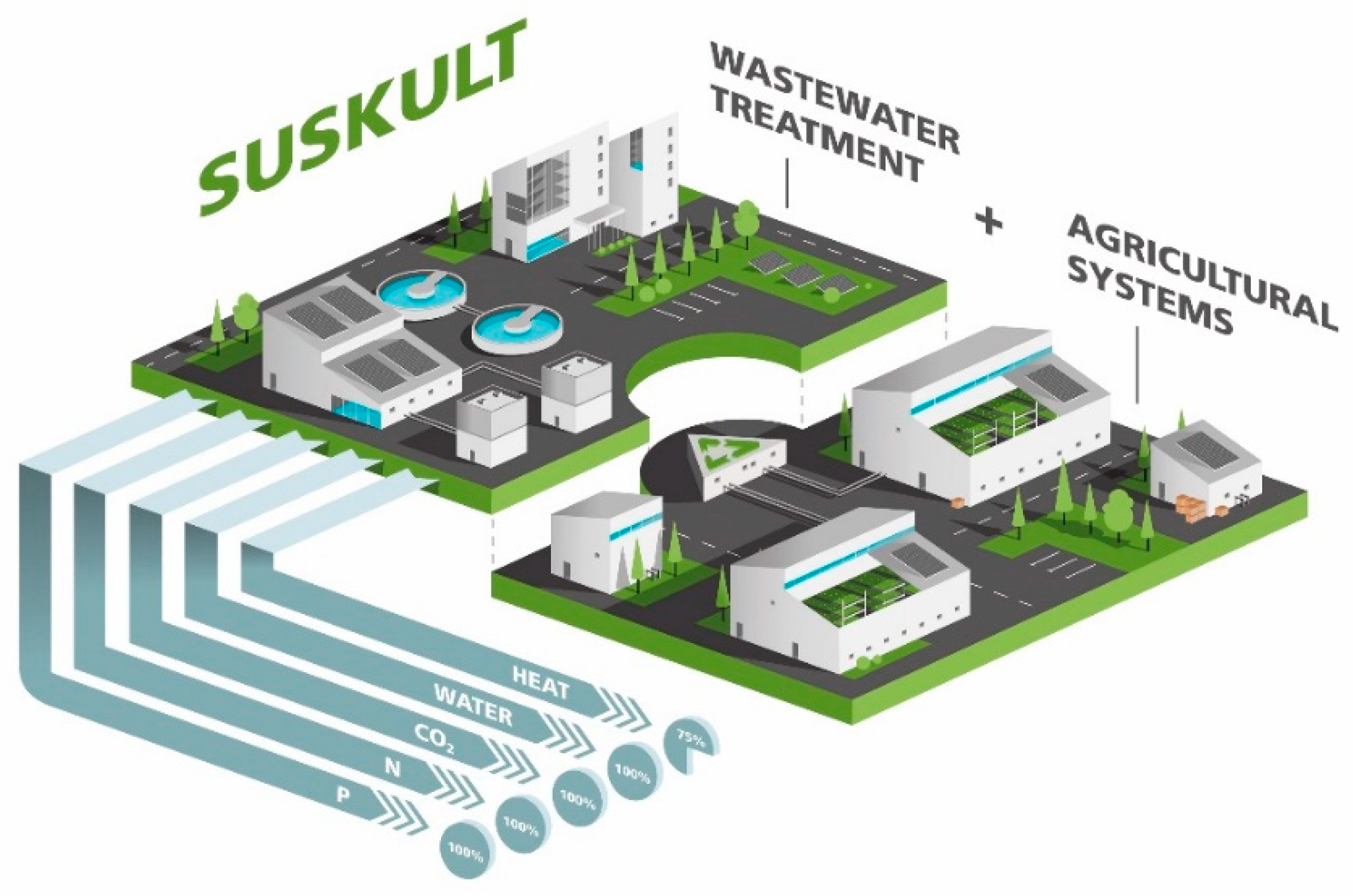
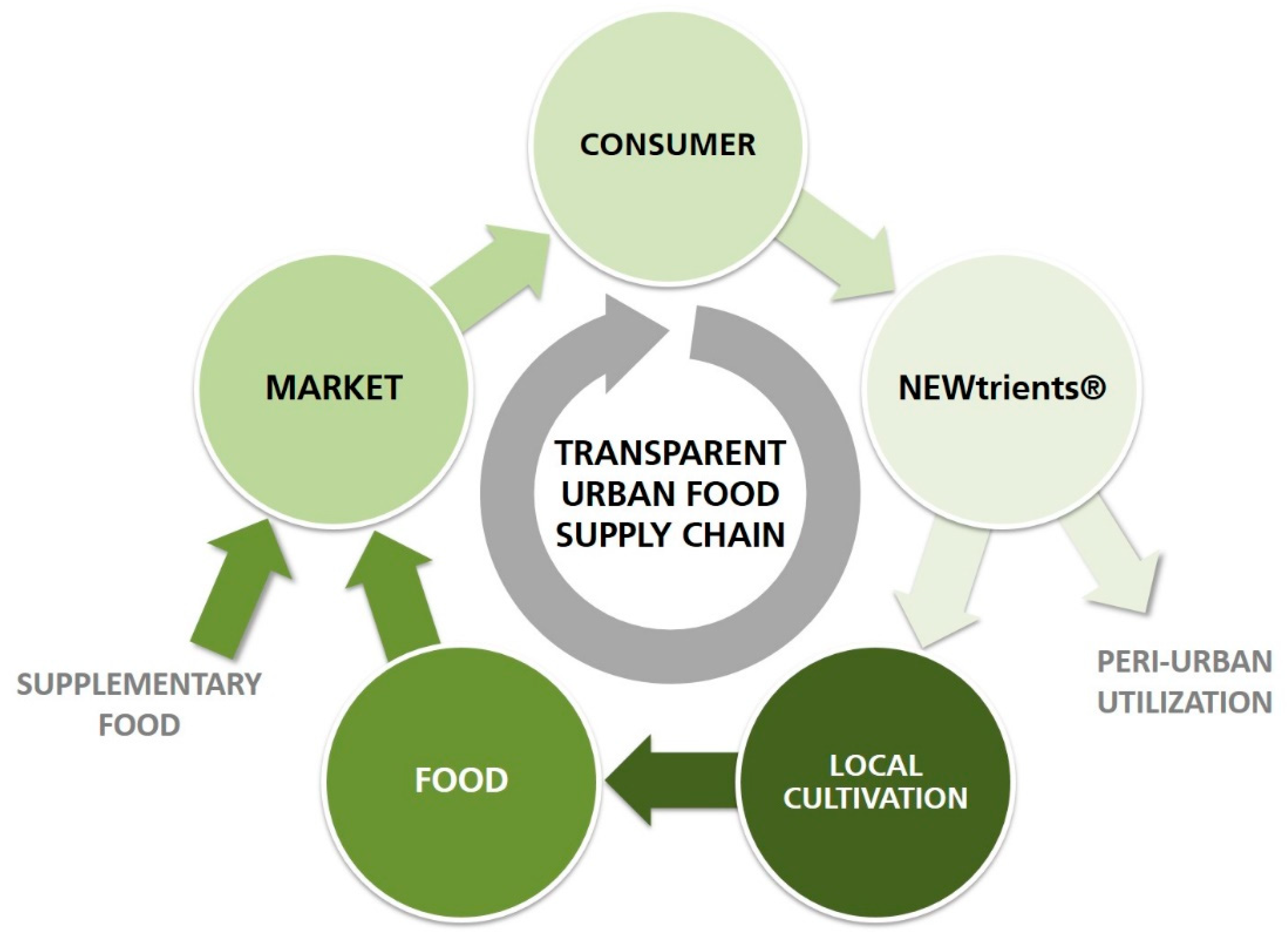
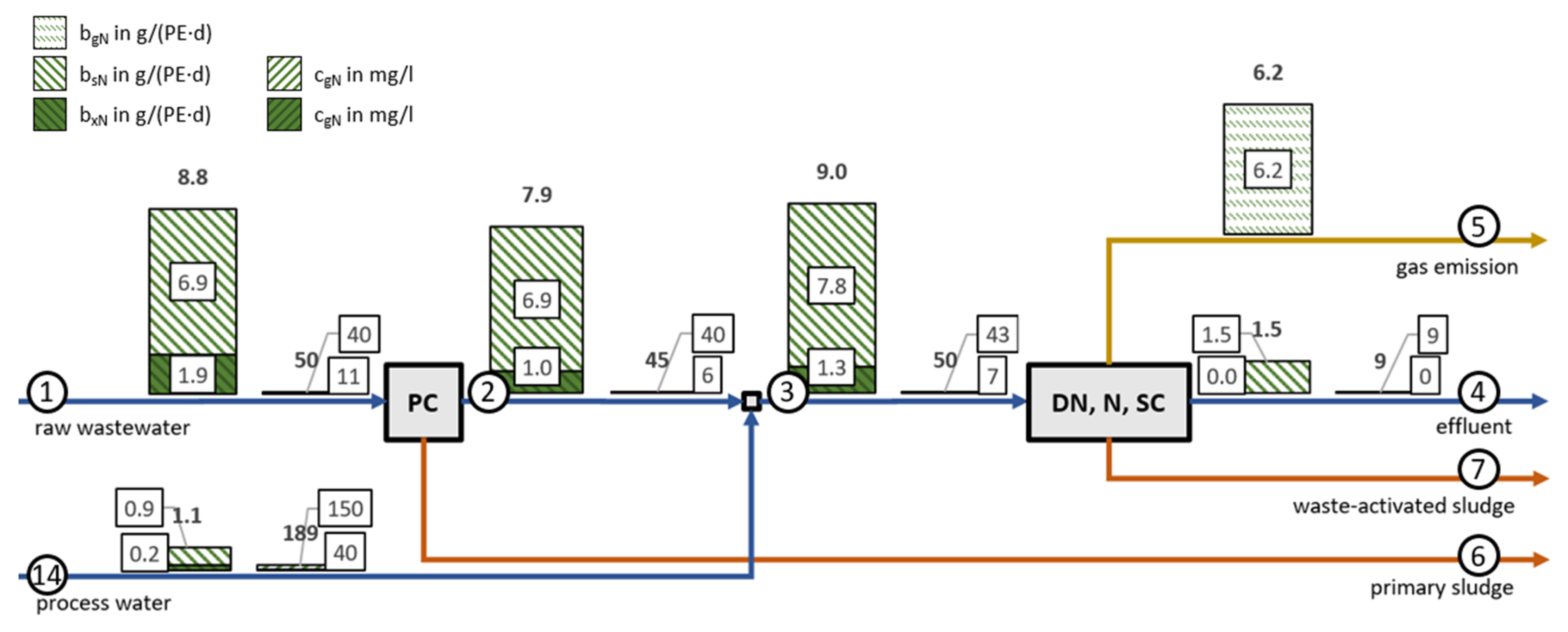

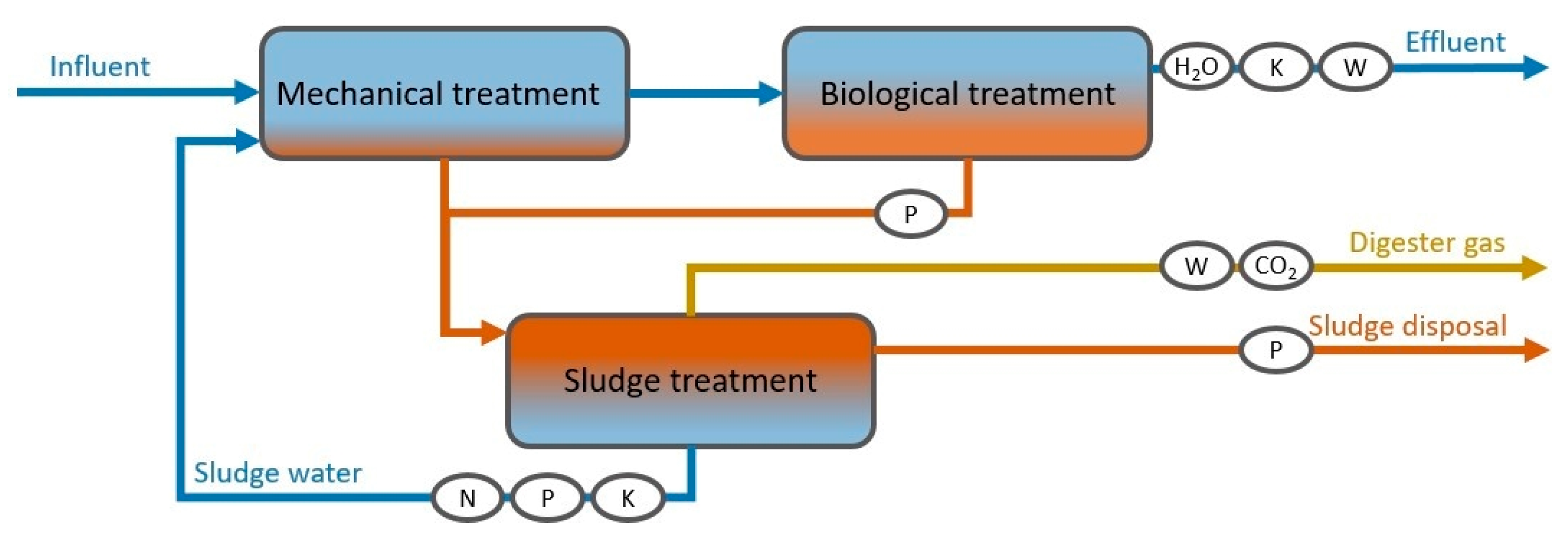
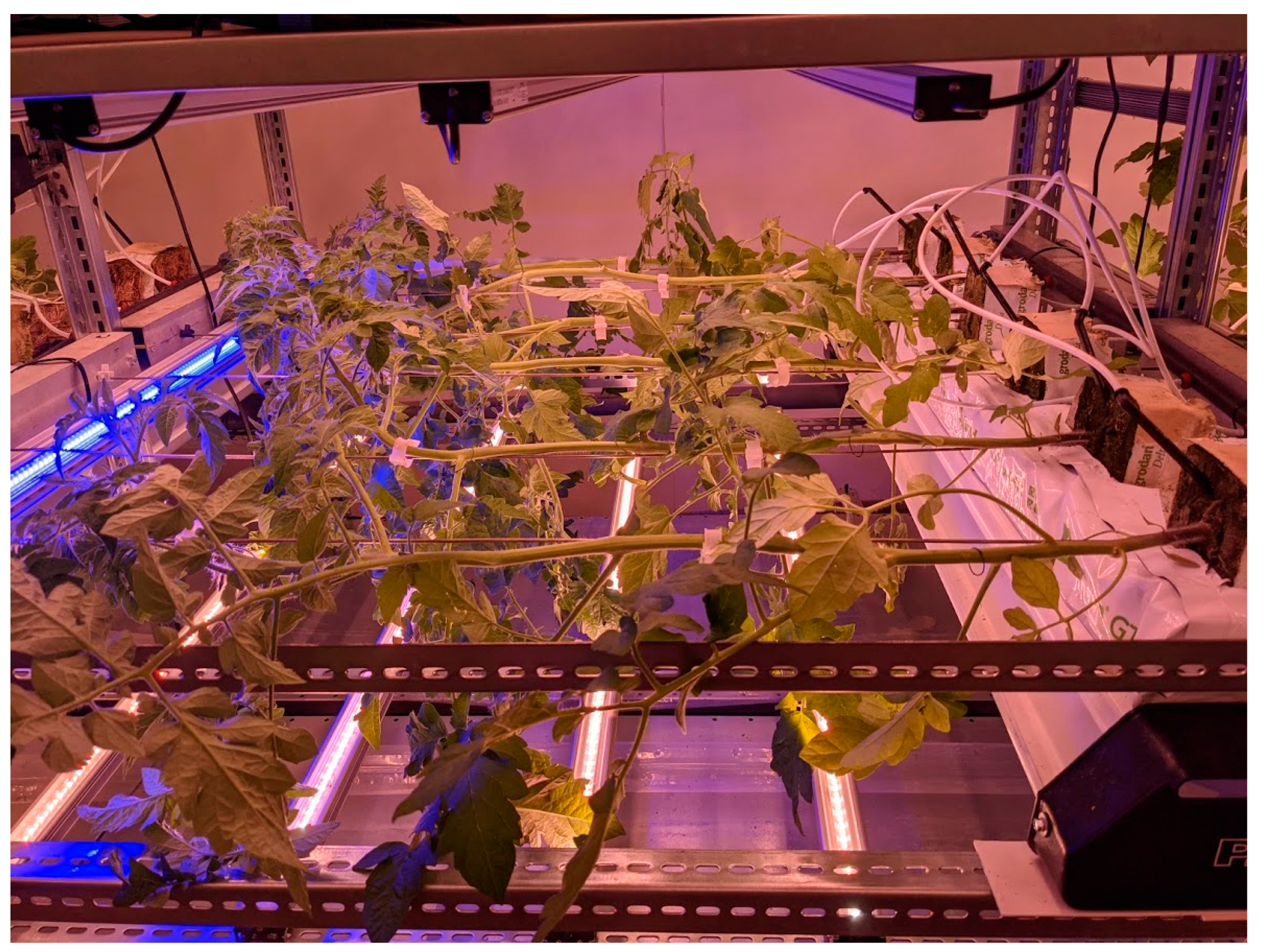
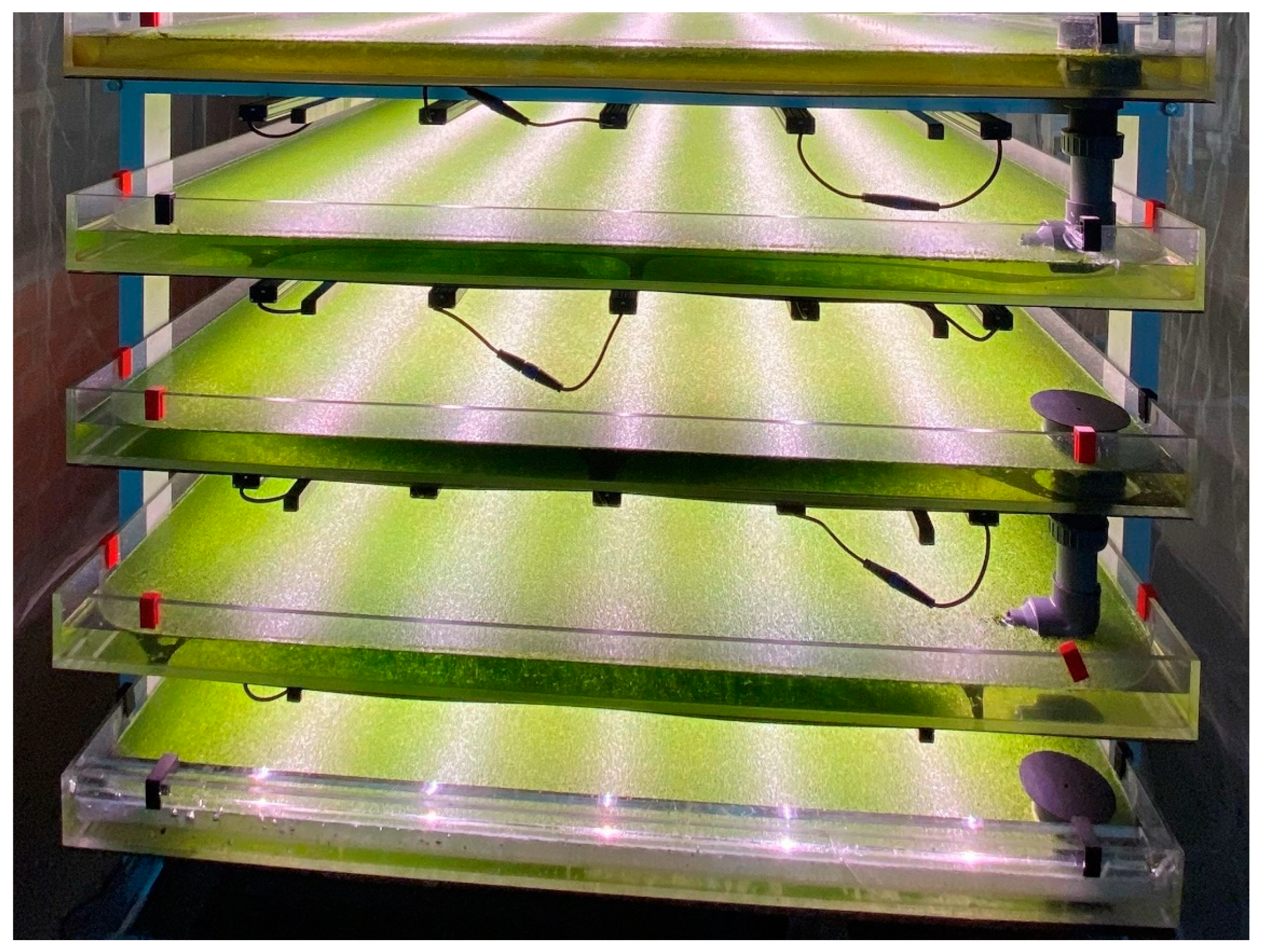
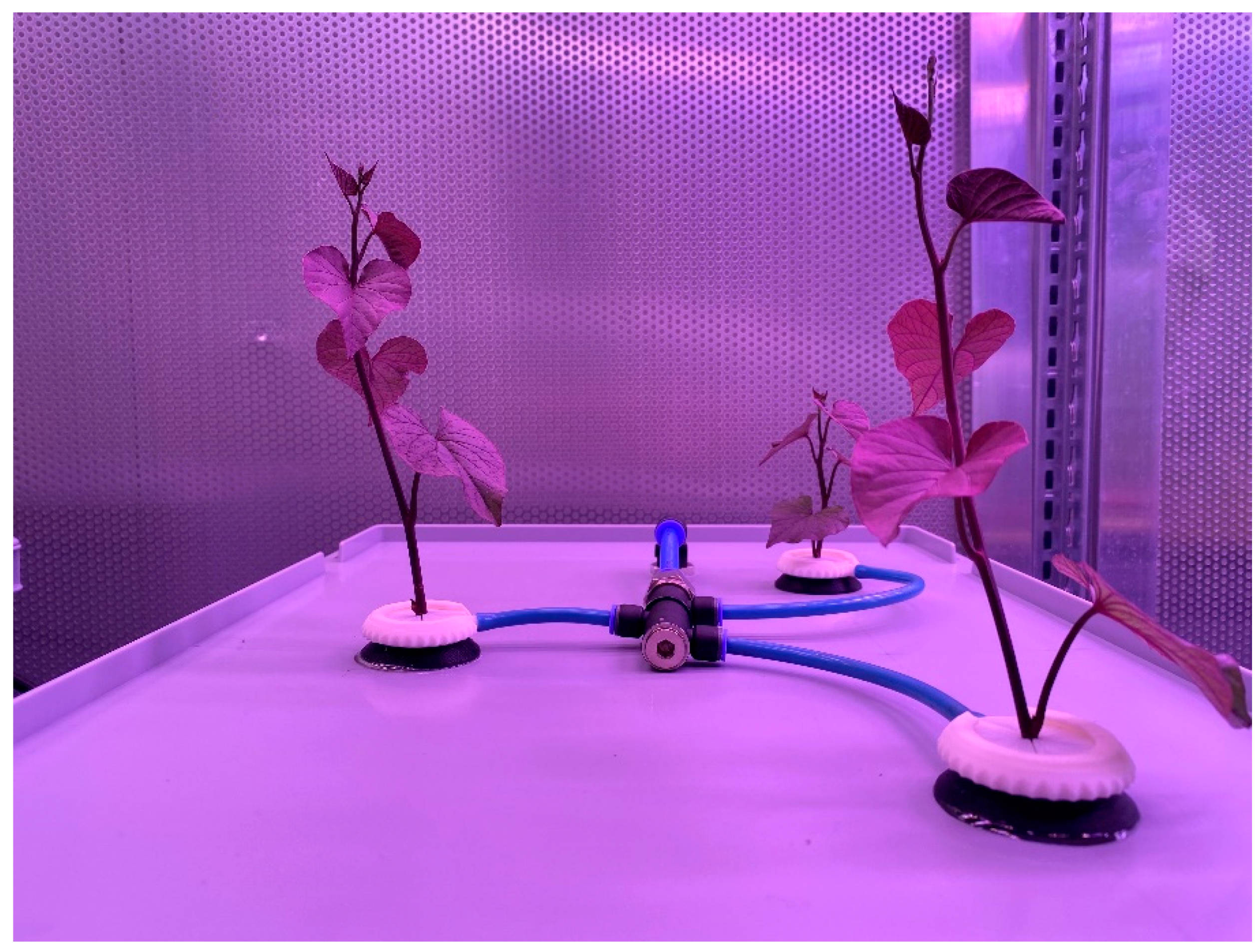
| Material Flow/Process | Assumptions and Calculation Methods |
|---|---|
| Raw wastewater | |
| Nutrient loads: | N = 8.8 g/(PE∙d) [38,39] **; xN = 1.9 g/(PE∙d) calculated according to [40,41]; P = 1.4 g/(PE∙d) [38,39] **; sP = 2/3∙P [42]; K = 4.9 g/(PE∙d) [43]; sK = 0.975∙K [44] |
| Volume flows: | Q = 175 L/(PE∙d) [41]; QDW = 130 L/(PE∙d); [45]; QHW = 0.3∙Qdw [42] |
| Further parameters: | COD = 96 g/(PE∙d) [38,39] **; xCOD = 62.7 g/(PE∙d) calculated according to [41] with 1,6 gCOD/gVS; TS= 56 g/(PE∙d) [38,39]; VS = 0.7∙TS |
| Primary clarifier | |
| Clarifier: | Separation efficiency according to [41] with τ = 1 h: ηN = 10%; ηP = 10%; ηTS = 50%; ηCOD = 30%; ηxCOD = 45%, K no enhanced separation assumed |
| Sludge parameters: | TS = 4% [39]; VS = 0.75∙TS [39]; RBS = 0.7∙VS [39] |
| Biological Treatment (denitrification, nitrification, phosphorous removal, secondary clarifier) | |
| Biological process: | Calculation for COD, N, P, TS, vs. according to [41] with Tdesign = 12 °C; SRT = 15 d and average influence factors; xKBM = 0.3∙PBM [46] |
| Effluent: | sNinorg = 6.5 mg/L; sP= 0.5 mg/L dissolved effluent concentrations of N and P were assumed 50% of permissible emission standards in Germany for a WWTP > 6.000 kg BOD5/d; Norg = 2 mg/L [41]; TS= 12 mg/L [41,47] |
| Waste-activated sludge parameters: | TS= 0.7% [39]; RBS = 0.45∙VS [39] |
| Sludge thickener | TS = 5% [39]; TS separation efficiency 90% [48] |
| Digestion | |
| Gas production: | T = 37 °C [39]; SRT = 20 d [39]; degradable rate of RBS = 85% [39]; gas yield primary sludge = 0.95 m3 i.s.s./kg [39]; gas yield waste-activated sludge = 0.85 m3 i.s.s./kg [39]; digester gas composition: 1/3 CO2 and 2/3 CH4 [39] |
| Dissolution: | Calculation of N, P and K dissolution according to [49]; assumed P refixation with xP = 0.95∙P [50] |
| Dewatering | Centrifuge assumed: separation efficiency 98% [51,52]; TS = 26% [51] |
| Heat usage | |
| Water temperature: | Calculation according to [42] with THW = 35 °C [42]; TPW= 10 °C [42]; TIW= 10 °C [42]; no heat loss assumed; |
| Usable heat: | calculation according to [53] with Tmin in effluent = 5 °C and Tmin previous to biological treatment = Tdesign; no heat usage in sludge treatment previous to digester assumed |
| CO2 1 | N 1 | xN 1 | sN 1 | P 1 | xP 1 | sP 1 | K 1 | xK 1 | sK 1 | Q 2 | W 3 | |
|---|---|---|---|---|---|---|---|---|---|---|---|---|
| 1 | 0.0 | 8.8 | 1.9 | 6.9 | 1.4 | 0.5 | 1.0 | 4.9 | 0.1 | 4.8 | 175 | 725 |
| 2 | 0.0 | 7.9 | 1.0 | 6.9 | 1.3 | 0.3 | 1.0 | 4.9 | 0.1 | 4.8 | 174 | 722 |
| 3 | 0.0 | 9.0 | 1.3 | 7.8 | 1.6 | 0.5 | 1.0 | 5.1 | 0.1 | 5.0 | 180 | 746 |
| 4 | 0,.0 | 1.5 | 0.0 | 1.5 | 0.1 | 0.0 | 0.1 | 4.8 | 0.0 | 4.8 | 175 | 2146 |
| 5 4 | 58.0 | 6.2 | 0.0 | 0.0 | 0.0 | 0.0 | 0.0 | 0.0 | 0.0 | 0.0 | 0 | 0 |
| 6 | 0.0 | 0.9 | 0.9 | 0.0 | 0.1 | 0.1 | 0.0 | 0.1 | 0.1 | 0.0 | 1 | 0 |
| 7 | 0.0 | 1.3 | 1.3 | 0.0 | 1.5 | 1.5 | 0.0 | 0.3 | 0.2 | 0.1 | 5 | 0 |
| 8 | 0.0 | 2.2 | 2.1 | 0.1 | 1.6 | 1.6 | 0.0 | 0.4 | 0.2 | 0.2 | 6 | 0 |
| 9 | 0.0 | 1.9 | 1.9 | 0.0 | 1.4 | 1.4 | 0.0 | 0.2 | 0.2 | 0.0 | 1 | 0 |
| 10 | 0.0 | 1.9 | 1.0 | 0.9 | 1.4 | 1.2 | 0.3 | 0.2 | 0.1 | 0.1 | 1 | 32 |
| 11 | 0.0 | 1.1 | 1.0 | 0.1 | 1.3 | 1.3 | 0.0 | 0.1 | 0.1 | 0.0 | 0 | 5 |
| 12 | 0.0 | 0.3 | 0.2 | 0.1 | 0.2 | 0.2 | 0.0 | 0.2 | 0.0 | 0.1 | 5 | 19 |
| 13 | 0.0 | 0.8 | 0.0 | 0.8 | 0.1 | 0.0 | 0.1 | 0.1 | 0.0 | 0.1 | 1 | 34 |
| 14 | 0.0 | 1.1 | 0.2 | 0.9 | 0.3 | 0.2 | 0.1 | 0.3 | 0.0 | 0.2 | 6 | 53 |
| 15 4 | 11.8 | 0.0 | 0.0 | 0.0 | 0.0 | 0.0 | 0.0 | 0.0 | 0.0 | 0.0 | 0 | 0 |
| Date | Type of Survey | Tool | Real-Time Interaction between Researchers and Stakeholders | Format | Participants | Sample (n) |
|---|---|---|---|---|---|---|
| 2–16 September 2019 | stakeholder survey | Lime Survey | / | online | internal and external stakeholders | 29 |
| 10 December 2019 | student survey | written survey | √ | on-site | students from Justus Liebig-University Giessen | 75 |
| September 2019 March 2020 | five expert interviews | semi-structured interview | √ | on-site and by telephone | representatives from the public sector and private companies | 5 |
| September 2020 | stakeholder survey | / | online | Twitter users | 526 | |
| 12 September 2020 | stakeholder survey | Mentimeter | √ | on-site | audience of a public panel discussion | 17 |
| 11 November 2020 | student survey | Sli.do | √ | online | students from Justus Liebig University Gießen | 143 |
| 26 November–3 December 2020 | student survey | Lime Survey | / | online | students from Bauhaus-Universität Weimar | 18 |
| 17 December 2020 | stakeholder discussion | group discussion | √ | online | students from Bauhaus-Universität Weimar | 43 |
| 4 December 2020 | three integrated stakeholder workshops | group discussion | √ | online | internal and external stakeholders | 39 |
| 2 July 2021 | focus group workshop | group discussion | √ | online | internal and external stakeholders from the food retailing and agricultural sectors | 19 |
| 914 | ||||||
Publisher’s Note: MDPI stays neutral with regard to jurisdictional claims in published maps and institutional affiliations. |
© 2021 by the authors. Licensee MDPI, Basel, Switzerland. This article is an open access article distributed under the terms and conditions of the Creative Commons Attribution (CC BY) license (https://creativecommons.org/licenses/by/4.0/).
Share and Cite
Keuter, V.; Deck, S.; Giesenkamp, H.; Gonglach, D.; Katayama, V.T.; Liesegang, S.; Petersen, F.; Schwindenhammer, S.; Steinmetz, H.; Ulbrich, A. Significance and Vision of Nutrient Recovery for Sustainable City Food Systems in Germany by 2050. Sustainability 2021, 13, 10772. https://doi.org/10.3390/su131910772
Keuter V, Deck S, Giesenkamp H, Gonglach D, Katayama VT, Liesegang S, Petersen F, Schwindenhammer S, Steinmetz H, Ulbrich A. Significance and Vision of Nutrient Recovery for Sustainable City Food Systems in Germany by 2050. Sustainability. 2021; 13(19):10772. https://doi.org/10.3390/su131910772
Chicago/Turabian StyleKeuter, Volkmar, Sebastian Deck, Heidi Giesenkamp, Denise Gonglach, Victor Takazi Katayama, Sica Liesegang, Finn Petersen, Sandra Schwindenhammer, Heidrun Steinmetz, and Andreas Ulbrich. 2021. "Significance and Vision of Nutrient Recovery for Sustainable City Food Systems in Germany by 2050" Sustainability 13, no. 19: 10772. https://doi.org/10.3390/su131910772
APA StyleKeuter, V., Deck, S., Giesenkamp, H., Gonglach, D., Katayama, V. T., Liesegang, S., Petersen, F., Schwindenhammer, S., Steinmetz, H., & Ulbrich, A. (2021). Significance and Vision of Nutrient Recovery for Sustainable City Food Systems in Germany by 2050. Sustainability, 13(19), 10772. https://doi.org/10.3390/su131910772







